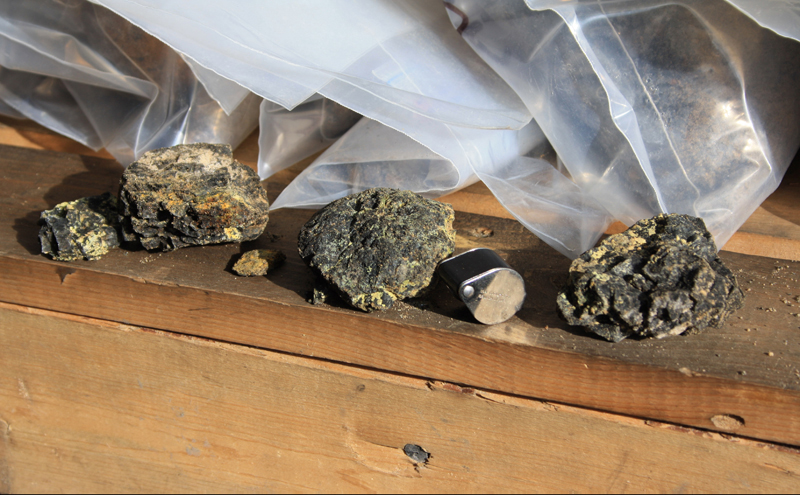
Located in the Canadian Shield of northern Saskatchewan and Alberta, Canada, the Athabasca Basin is the world’s leading source of high grade uranium and currently supplies approximately 20 percent of all that used across the planet. Covering some 100,000 square kilometres of Saskatchewan, and a small portion of Alberta, the surface of the basin consists of sandstone sediment varying from 100 to 1,000 metres in depth. It is at the base of this sandstone that uranium ore has been mostly found since it was first discovered in the region in the 1940s.
Today a number of high-grade uranium mines are scattered across the basin. One company whose own activities are primarily focused on the discovery and delineation of deposits in the region is Alpha Minerals. A junior mineral exploration company with strategically selected uranium and gold properties in North America, it has a proven record for making high-grade discoveries, including the recent near-surface discovery at Patterson Lake South.
The Patterson Lake South (PLS) property is the most advanced of Alpha Minerals’ projects in the Athabasca Basin, which collectively cover an area of over 170,000 acres. The project, which includes 17 claims that straddle the south-western margin of the basin, is a 50/50 joint venture between Alpha Minerals and Fisson Uranium Corporation.
To date, a total of 156 boulders and 32 soil samples from the property have been submitted for assay. Of the 188 geochem samples, 33.5 percent were found to contain less than one percent of triuranium octoxide (U3O8), 26.6 percent contained between one and ten percent and 39.9 percent had over ten percent. The highest grade assayed at 40 percent U3O8. Since the autumn of 2012, the company has carried out regular drill assays, the latest of which were released in August 2013. This event involved the drilling of an additional five holes on the Properties R39OE zone, which returned 54 metres of 9.08 percent U3O8, which included 21.5 metres of 21.76 percent U3O8 and assays of up to 52.2 percent.
In addition to the PLS property, Alpha Minerals can also lay claim to both the Cluff Lake and Hook Lake assets within the Athabasca Basin. The former covers a collective area of 41,380 acres, within which the company operates under a joint venture with Rio Tinto. The project itself adjoins the former Cluff Lake open pit mine, which was responsible for producing 63 million pounds of U3O8 at a grade of 0.93 percent during its lifetime.
Meanwhile, located northeast of the company’s PLS discoveries, Hook Lake covers some 32,000 acres of land within the basin. The area, known to be prospective for unconformity hosted uranium deposits, has been subject to comprehensive exploration in the past by the likes of UEM Inc., Cameco Corporation and Imperial Oil Limited. This has seen it subjected to airborne ground geophysical surveying, geochemical sampling and diamond drilling totalling over 2,400 metres. These tests have helped identify 17 electromagnetic conductors with a total strike length of 80 kilometres. Three of these conductors have been drill tested, with one intersecting 0.24 percent U3O8 over 2.5 metres.
In addition to its uranium activities, the company holds two gold assets, the Donna Gold Property in British Columbia and the Mikwam Gold Property in Ontario. The former lies within one of the largest clusters of anomalous values in stream sediments for gold and its typical pathfinders found anywhere else.
Alpha Minerals obtained and reviewed various reports concerning past exploration work conducted on the Donna property. These indicated a strong linear zone of gold values intersected by four trenches over a distance of 250 metres and open on both ends, to the North West and South East. Corresponding soil samples ranging from trace to 4,200 parts per billion of gold were found covering and surrounding this area.
Initial drilling of targets related to the known gold zones was completed by the company in 2010. The results indicate a strongly anomalous zone that extends west from the trenching and is as yet undrilled further to the west along the soils anomaly. Understandably the company was and is very encouraged by this initial drill programme as it further identified the targets on the western side of earlier trenching and a gold anomaly in soils that extends more than 1,600 metres along the height of land between the Kettle River and Yeoward Creek, which are both historical gold placer producers.
The Mikwam Gold property on the other hand lays North East of Timmins, on the Casa Berardi Deformation Zone. An area of historical gold and other precious metals mineralization, the zone has in the past played host to exploration work costing in excess of $12 million, carried out by companies such as Newmont. The property remains on trend with the nearby Casa Berardi gold mine, operated by Hecla Mining, while recent drill programme highlights include identifying 4.10 g/t gold over 19.0 metres, 4.99 g/t gold over 13.0 metres and 6.32 g/t gold over 5.6 metres.
With both its uranium and gold assets now producing sustained results, an event that at one point this year saw its shares hit a peak of $5 dollars per share, having previously been at a low of $0.20, there is much for Alpha Minerals to be positive about as we approach the New Year.
Written by Will Daynes, research by Peter Rowlston



 AplhaMinerals-Americas-Mining-Jan14-Bro-s.pdf
AplhaMinerals-Americas-Mining-Jan14-Bro-s.pdf









